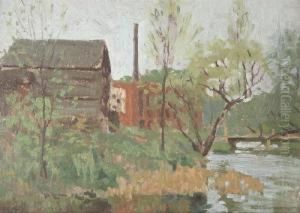Ernest Nathaniel Townsend Paintings
Ernest Nathaniel Townsend was a distinguished British artist, known for his contributions to portrait and landscape painting. Born on May 1, 1880, in Derby, England, Townsend grew up in an era that saw the transition from Victorian to Edwardian art styles, a period that undoubtedly influenced his artistic development. He demonstrated an early talent for drawing and painting, which led him to pursue formal education in the arts. Townsend's academic journey in art took him to prestigious institutions such as the Derby School of Art, followed by the Royal College of Art in London, and eventually, the Académie Julian in Paris. These experiences exposed him to a diverse range of artistic teachings and styles, from traditional British techniques to the avant-garde movements burgeoning in Paris at the time.
Throughout his career, Townsend was lauded for his ability to capture the essence of his subjects, particularly in his portraits, which ranged from depictions of prominent societal figures to intimate portrayals of everyday people. His landscapes, on the other hand, often depicted the English countryside, reflecting a deep appreciation and understanding of his homeland's natural beauty. Despite the changing tides of artistic trends throughout his life, Townsend remained committed to realism, a style that he both mastered and innovated upon in his work.
Townsend's contributions to the art world were recognized in his time, and he was a respected member of various artistic circles and societies. He exhibited widely, including at the Royal Academy in London, where his works received critical acclaim. His paintings are now housed in numerous public and private collections, serving as a testament to his skill and vision.
Ernest Nathaniel Townsend's legacy is not just in the paintings he left behind but also in the influence he had on subsequent generations of artists. He continued to paint and contribute to the British art scene until his death on January 22, 1944, in Derby. Townsend's dedication to capturing the reality and beauty of his subjects has cemented his place in the annals of British art history, making him a figure of enduring significance.
